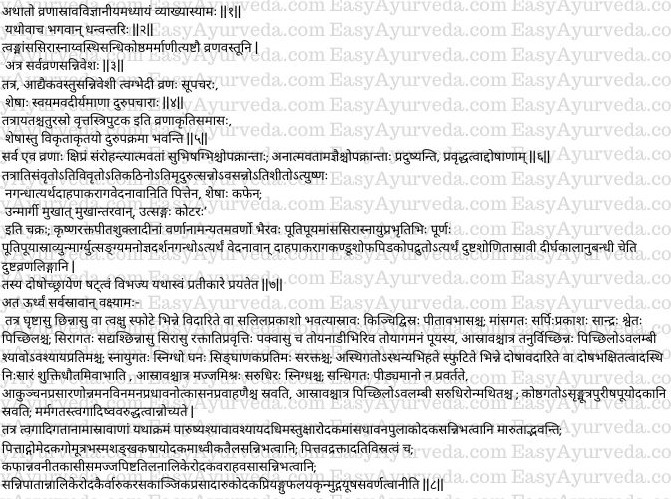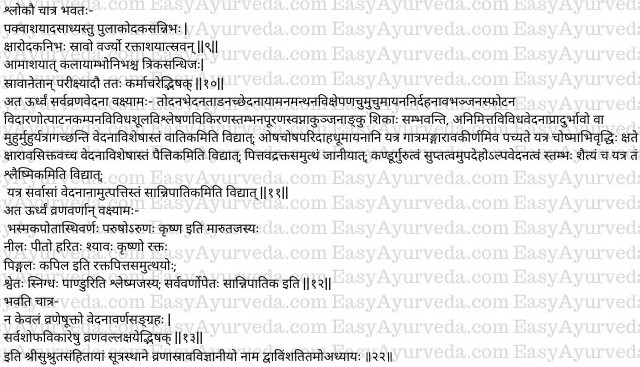
This article explains Sushruta Samhita Sutrasthana Chapter 22 “Vrana Srava Vijnaniya Adhyaya” – Knowledge of exudates of the wound.
Vrana Srava Vijnaniya
Knowledge of exudates of the wound
Now, we all expound the chapter called Vranasrava vijnaniya- knowledge of exudates of the wound, as revealed by the venerable Dhanvantari.
Read – Lord Dhanwantari ‘The God of Ayurveda

Vranavastu
Seats of wounds
Below mentioned are the eight vrana vastus (seats, dwelling places of wounds / ulcers) –
- Twak – skin
- Mamsa – muscles
- Sira – veins
- Snayu – ligaments
- Asthi – bones
- Sandhi – bony joints
- Kostha – abdominal viscera and
- Marma – vital spots, vital organs
In these seats all kinds of wounds happen.
Prognosis of wounds located in vrana vastu
Twak Bhedi Vrana i.e., that wound or ulcer which happens in the first seat (skin) and causing tear in the skin only is easily treatable, while the remaining kinds (residing in other tissues) and bursting by themselves are treatable with difficulty.
Read – Madhava Nidana Chapter 43 Sadyo Vrana Nidanam
Vranakriti
Different shapes of wounds
Broad, rectangular, round and triangular – are the shapes of the wounds, in brief; others of abnormal shapes are difficult to treat.
Prognosis of wounds based on the physician treating the wounds
All kinds of wounds heal quickly in persons who are disciplined (use only healthy food and behave as directed by the physician) and treated by a good physician. On the other hand, those who are not disciplined and treated by ignorant physicians, lead to great abnormality, because of the great increase of the doshas.
Read – Sushruta Samhita Chapter 18 Vranalepana Bandhana Vidhi Adhyaya
Dusta Vrana Lakshana
Features of bad (septic) wound
Below mentioned are the symptoms of dusta vrana (vitiated / septic wound) –
- either has small opening or large opening, (greatly covered and slightly exposed or greatly exposed and slightly covered),
- excessively hard or very soft,
- elevated or depressed,
- excessively cold or excessively warm / hot,
- having any one among black, red, yellow or white colors,
- terrifying (by appearance),
- filled with / associated with putrefying (foul smelling) pus, blood, muscles, veins, ligaments etc.,
- exuding putrefying pus and exudates moving in abnormal paths,
- wound raised up,
- having unpleasant look (ugly in appearance) and smell (foul smelling);
- accompanied with severe pain, burning sensation, suppuration, redness, itching, swelling, eruptions and such other complications greatly;
- exuding
- vitiated blood and persisting for long time
It should be classified into six kinds on the basis of predominance of the Doshas and appropriate treatments to each be administered, with all efforts.
Read – Charaka Vrana Chikitsa – 25th Chapter – Wounds, Ulcers
Srava Lakshanas
Features of the exudates
Further on, we well describe the features of all types of exudates;
In wounds such as Ghrista (abrasion), chinna (cut, incised) and that due to bursting or tearing of vesicles (bleeds), the exudates will be water like with slight bad smell and yellow color.
Mamsagata Vrana – The exudates coming from the wounds residing in the muscles, resembles ghee, thick, white and slimy.
Siragata Vrana – In wounds of the veins, caused by sudden accidental cuts, there will be too much bleeding. When the wounds get matured (suppurated), the pus (exudates) will be like water coming out from a tube (sinus). Such exudates will be thin, discontinuous, slimy, adhering, and black and resembling dew drops.
Snayugata Vrana – The exudates coming from the wounds present in the ligaments, will be unctuous, thick, resembling nasal exudation and mixed with blood.
Asthigata Vrana – In wounds of the bones due to injury such as splitting, dividing or got cracked by aggravated doshas, the bone getting eaten (destroyed) by the Doshas (worms, microbes), becomes sapless (poor in strength and weight), resembles wash of oyster shells (shining white) and the exudates are unctuous and are mixed with marrow and blood.
Sandhisthita Vrana – When the wounds are present in the joints, the exudates will not flow out even by pressing them. On the other hand, the exudates would flow out during flexion, extension, elevation, depression, running, coughing and straining. The exudates will be slimy, resembling streaks of syrup hanging down (just like saliva dribbles from the corner of the mouth), mixed with froth, pus and blood.
Kosthagata Vrana – In those wounds present in the abdomen (viscera), there will be exudation of blood, urine, feces, pus and water (serous fluid).
Marmagata Vrana – In the wounds of vital spots, nature of exudation is not described separately since these are included under the skin etc. (explanation of exudation from the wounds located in the skin etc.).
Features of exudates of wounds of the skin (muscles, ligaments, veins) etc. depending on the doshas involved will be explained in respective order as follows –
Vata symptoms
When vata is involved in the wounds, the discharges produced therein (depending on from which vrana vastu – seat of wound the exudates is flowing) are-
- rough – in exudates of skin
- black (blackish blue) – in exudates of muscles
- dew drop – in exudates of veins
- whey – in exudates of ligaments
- alkali solution – in exudates of bones
- mutton wash – in exudates of joints
- boiled rice wash (gruel) – in exudates of abdominal viscera
Pitta symptoms
When pitta is involved in the wounds, the discharges produced therein (depending on from which vrana vastu – seat of wound the exudates is flowing) are-
- gomedaka – in exudates of skin
- cow’s urine – in exudates of muscles
- conch – in exudates of veins
- solution of ash – in exudates of ligaments
- decoction – in exudates of bones
- madhvika – in exudates of joints
- taila / oil – in exudates of abdominal viscera
Rakta symptoms – are similar to those of pitta along with too much of bad smell in the exudates.
Kapha symptoms
When kapha is involved in the wounds, the discharges produced therein (depending on from which vrana vastu – seat of wound the exudates is flowing) are-
- butter – in exudates of skin
- kasisa / ferrous sulfate – in exudates of muscles
- marrow – in exudates of veins
- flour – in exudates of ligaments
- sesame – in exudates of bones
- coconut water – in exudates of joints
- boar fat – in exudates of abdominal viscera
Sannipata symptoms – When all the three doshas are involved in the wounds, the exudates coming from them will be similar in color of coconut water, juice of ervaru (cucumber), scum of gruel, juice of Aruka (bhallataka), fruit of Priyangu, Yakrit (liver) and soup of Mudga (green gram) in exudates of skin, muscles, veins, ligaments, bones, joints and abdominal viscera respectively.
Exudates coming from various organs

Exudation from the Pakvashaya (large intestine) resembling water of boiled rice (or rice- wash) is incurable.
Exudation from the Raktashaya (liver and spleen) resembling solution of alkali / ash should be rejected.
Exudation from the Amashaya (stomach) resembling soup of Kalaya (round pea) and that (exudates) coming out from the Trika (upper back) through the alimentary tract – these should be examined first by the physician and suitable treatment adopted.
Read – Madhava Nidana Chapter 42 Shareera Vrana Nidanam
Vrana Vedana
Kinds of pains in the wounds
Next, we will describe the different kinds of pains of the wounds.
Pains caused by Vata predominance in the wounds – Pains such as piercing, tearing, hitting, cutting, dilating, churning, seizing, tingling, burning, crushing, breaking (blasting), tearing, plucking (as if de-rooted, plucked), trembling, various kinds of pain, splitting (as if separating or tearing into two), as if being thrown away in all directions, filling, stiffness, numbness (absence of pain or sensation), absence of pain (numbness), shrinking / sucking (as if flexing or withdrawing), pain as if pierced by hooks etc. and various kinds of pains developing without any apparent cause, and various kinds of pain appearing and disappearing frequently – if these symptoms are present it should be understood that they are caused by aggravated vata.
Pains caused by Pitta predominance in the wounds – Burning sensation locally, sucking pain, burning sensation all over the body, feeling of hot fumes coming out from inside, feeling as though the body is covered with burning coal, ulceration, increase of temperature (local and general), pain in the wounds as though smeared with alkali – are to be understood as caused by Pitta.
Pains caused by Rakta (blood) predominance in the wounds – Pains caused by rakta will be similar to those caused by pitta.
Pains caused by Kapha predominance in the wounds – Itching, feeling of heaviness, numbness, feeling as though something is adhering (body being coated by something), mild pain, stiffness (loss of movement) and coldness – these are to be understood as caused by kapha.
Pains caused by predominance of all three doshas in the wounds -Appearance of all types of pains together should be understood as caused by sannipata (combination of all three Doshas).
Read – Nadivrana – Sinus: Types, Symptoms, Ayurvedic Treatment
Vrana varna
Colour of wounds
Further we will describe the color of wounds: –
Colors produced by vata aggravation – color resembling ash, bone of pigeon, rough on touch and mild red and black colors.
Colors produced by pitta and rakta (blood) aggravation – blue, yellow, green, bluish black, black, red, brown, light brown colors.
Colors produced by kapha aggravation – white and pale in color.
Colors produced by aggravation of all the three doshas – manifestations of all colors are produced by sannipata (combination of all three doshas).
The different kinds of pains and colors mentioned so far are not for wounds only, these are to be understood as referring to all kinds of diseases arising with swelling. Thus ends the twenty second chapter by name Vranasrava vijnaniya in Sutra sthana of Sushrutha samhita.







